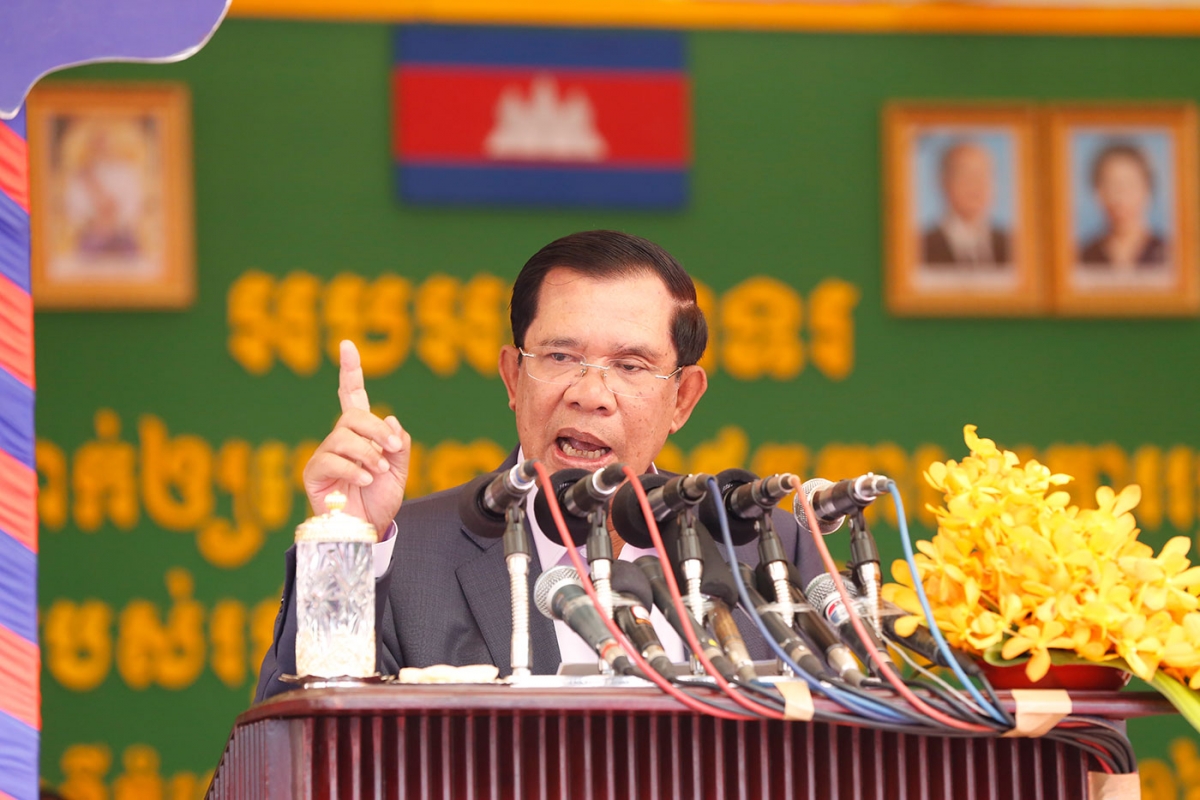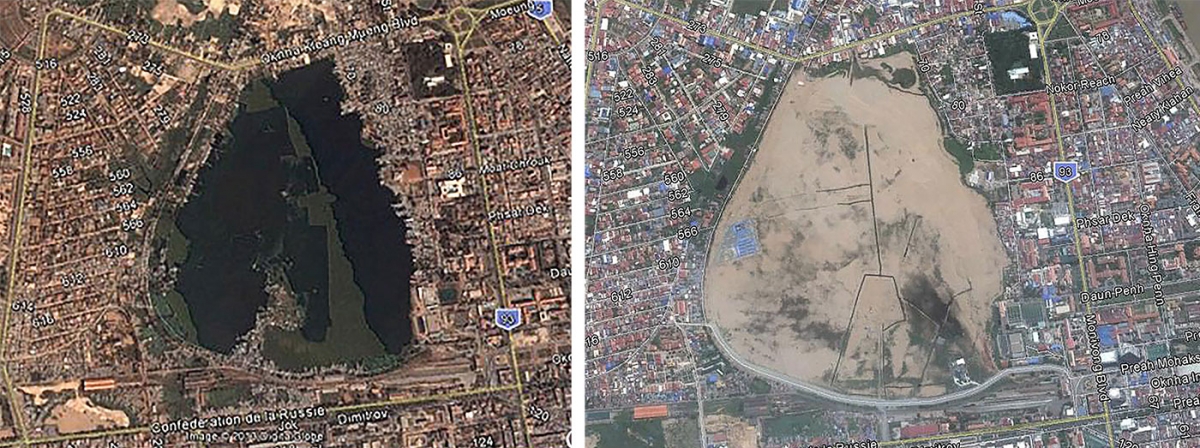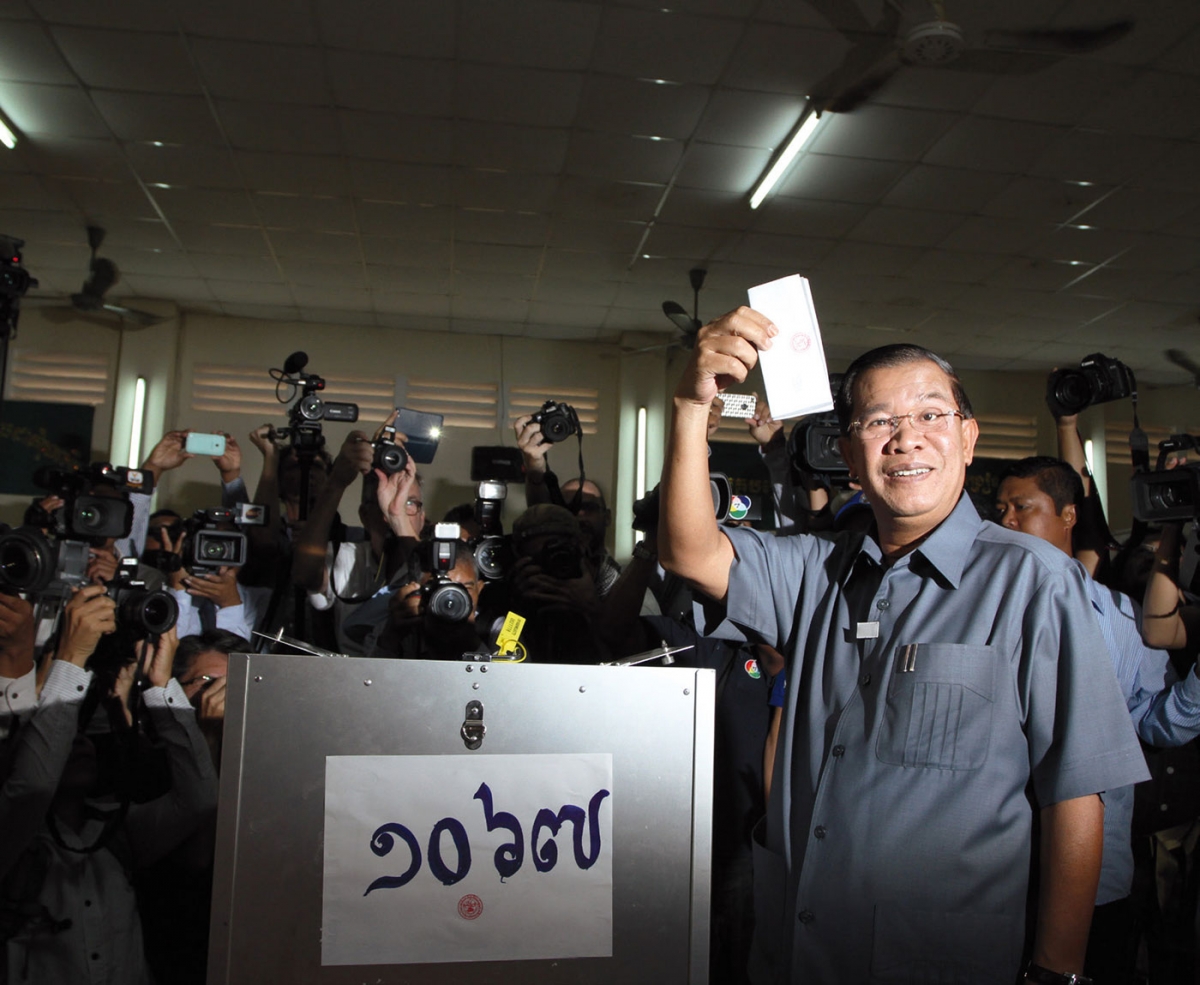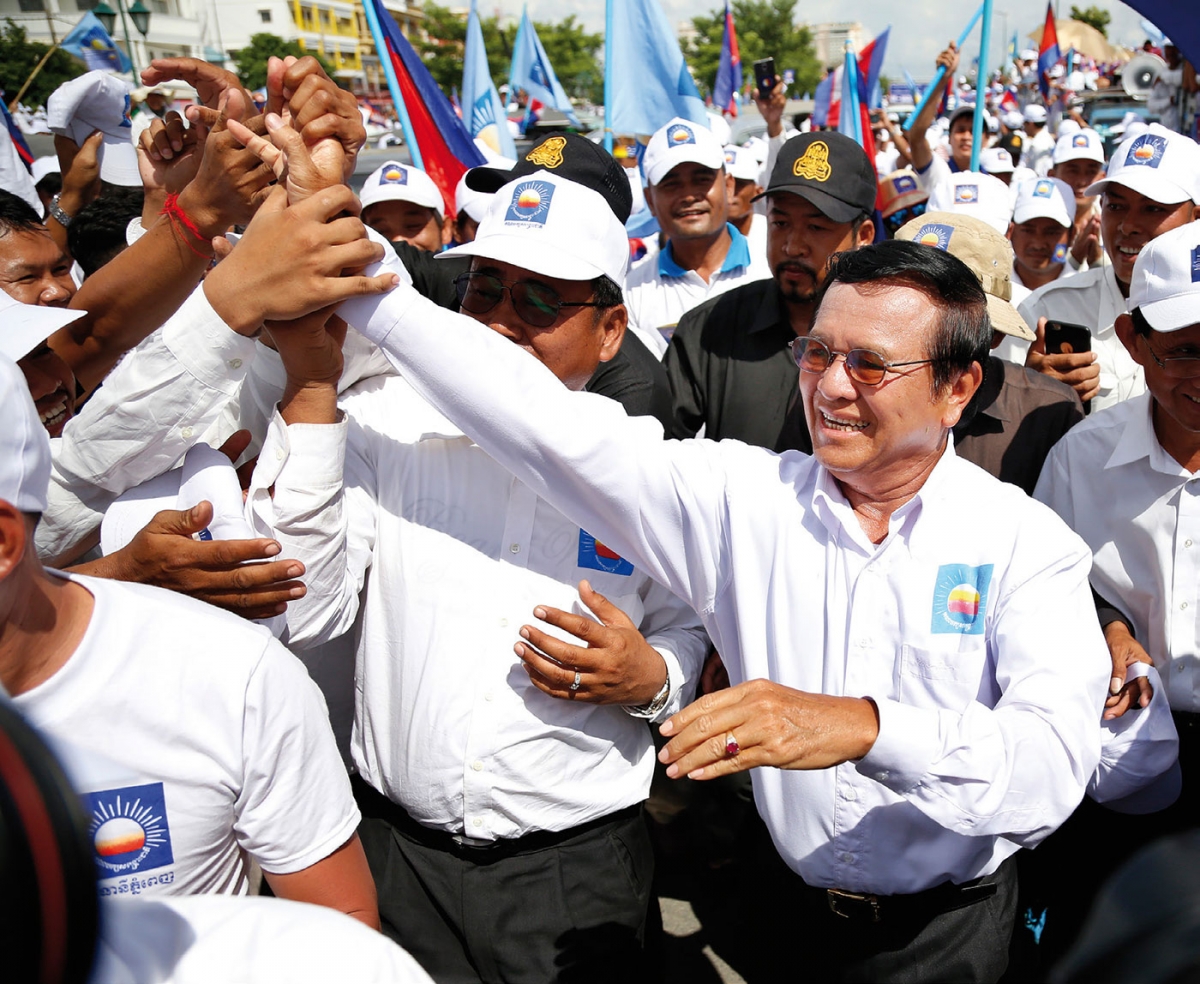Politics and society in contemporary Cambodia
Since the fall of the Khmer Rouge regime in 1979 Cambodian politics has been dominated by Prime Minister Hun Sen and his ruling Cambodian People’s Party (CPP). Hun Sen’s rise has complemented the emergence of a tight-knit elite comprising CPP ministers, lawmakers, local officials, business tycoons, police chiefs and military generals who have come to dominate and characterise Cambodia as a patrimonial society. The profits of the subsequent widespread marketisation of Cambodia’s natural resources, cheap labour and foreign investment are distributed within this elite, whilst the majority of the population remains bereft of the advantages of economic growth. In the process of consolidating its power-base and grip over the population, the CPP has extended its influence throughout society, from the commemoration of the Khmer Rouge atrocities to the distribution of television broadcasting licences, and from the designation of land concessions to the relocation of the urban and rural poor. This Focus Section explores the extent and nature of the CPP’s fingerprint on different societal spheres, including civil society, natural resources exploitation, urban business, education, agriculture, and the arts. Taken together, the contributions here reveal a political modus operandi, with its accompanying intended and unintended consequences for Cambodia. They arrive in the context of a politics that has facilitated the CPP’s domination, but now provokes an increasing challenge to this hegemony.
The rise of Hun Sen and the CPP
In February of 2017 the CPP amended the Law on Political Parties, thereby barring convicted criminals from political party leadership roles and conferring authority to the Ministry of Interior to dissolve political parties on the basis of making ‘serious mistakes’, threatening ‘national unity’, or ‘the security of the state’. The human rights office of the United Nations (UN) has protested the vague language and excessive restrictions contained within the amendments, because they provide “considerable discretion” for the Ministry of Interior to control the political process.1 No one has any doubt that the amendments were designed to debase Sam Rainsy, Hun Sen’s political rival who is currently living in exile in France, with the opposition suggesting the amendment “kills democracy in Cambodia”.2 Rainsy faces several convictions, including a five-year prison sentence over a Facebook post criticising the CPP. In the 2013 elections Rainsy’s Cambodia National Rescue Party (CNRP) won 55 seats while the CPP share fell from 90 to 68 seats, its worst performance since 1998. The results were striking considering the CPP’s control over the National Election Committee, state media and multiple reported electoral irregularities. Due, in no small part, to the amendments to the Law on Political Parties Sam Rainsy resigned from the CNRP to protect the party from dissolution, transferring the presidency to his former deputy, Kem Sokha. As this Focus Section goes to press, Kem Sokha has just been arrested on charges of treason and faces up to 30 years in prison, with the CPP claiming that Sokha has conspired with the United States to instigate regime change. CNRP representatives refuse to appoint yet another president, and hence Sokha’s arrest could spell the dissolution of the opposition party.
The amendments to the Law on Political Parties represent the latest move by the CPP to consolidate their power, part of an ongoing political strategy originating nearly four decades ago when Hun Sen touched down at Phnom Penh Airport on 11 January 1979. Four days earlier, Vietnamese troops had moved into Cambodia’s capital and ousted the Khmer Rouge regime, an extreme Maoist regime that led to the death of an estimated 1.5 to 2 million Cambodians and left the country decimated. The Vietnamese installed a regime including Hun Sen, Heng Samrin and Chea Sim. The three men were defected Khmer Rouge commanders who had fled to Vietnam in 1977-78 following a series of violent, paranoia driven internal purges instigated by Pol Pot, the head of the Khmer Rouge. The Vietnamese stayed in power for a decade (1979-1989); this allowed the three men, who still featured on CPP billboards together during the latest national elections campaign, to lay down their political roots. Hun Sen proved the most politically shrewd amongst them, and became prime minister in 1985.
Hun Sen has been characterised as a pragmatist, never a devoted communist.3 Since becoming prime minister he has developed his power-base through the exchange of political privileges and backing [khnorng] for financial contributions and loyalty to the CPP, which would gradually develop into the patronage network that now cements his position. The CPP elite incites loyalty amongst government officials by distributing opportunities for rent-seeking, and military generals have been allowed to make money from the land, timber and soldiers being put at their disposal. Similarly, business tycoons have been granted public contracts, import monopolies and land concessions in exchange for financial contributions to the CPP coffers and top-officials. As such, Hun Sen has erected a pyramid-like patronage system, himself the figurehead, whereby power flows down and money flows up. The patronage system rests on informal strings [khsae], reinforced at charity events, on the golf course and through strategic marriages between political, military and business elites. These patron-client arrangements produced an extractive elite that has subjugated the formal regulatory political system or, in other words, a weak state ruled by strong men.
Hun Sen first demonstrated the efficacy of his power-base in the 1990s. The departure of the Vietnamese in 1989 urged the involvement of the UN (1991-93), who initiated a peace-building mission to avoid another civil war. The UN aimed for reconciliation between Cambodia’s political factions including Hun Sen’s, the Royalists and the Khmer Rouge who still controlled Cambodia’s western provinces. Hun Sen lost the 1993 elections to the Royalist party headed by Price Rannaridh. However, he refused to relinquish power and eventually brokered a power-sharing coalition using control over the police and armed forces as leverage. The coalition was fragile and violent clashes broke out on 5-6 July 1997, during which armed forces loyal to Hun Sen gained the upper hand over Rannaridh’s forces. This resulted in Hun Sen’s coup de force, allegedly paid for by allied tycoons,4 marking the beginning of CPP hegemony. The CPP won the subsequent elections, elections dubbed a “miracle on the Mekong” by the head of the United States observatory delegation,5 increasing its seats in the National Assembly from 64 in 1998 to 73 in 2003 and 90 in 2008 (out of 123 seats).
The CPP blueprint for power was established. Through violence, intimidation and bribery, Hun Sen neutralised or co-opted the threat from political opposition outside and within his ranks. Meanwhile, he elicited votes by populist measures such as having roads, pagodas and so-called ‘Hun Sen schools’ built by proxy tycoons, and by reminding the largely rural electorate of the security risks involved in political pluralism, and the horrors of what came before. Following the 2003 elections Hun Sen placed loyalists in key positions, cementing his leadership and becoming synonymous with the CPP and, in extension, the Cambodian state. The consolidation of CPP power over the period since has fostered the expansion of state, business and military elites. Well-connected Cambodians have reaped the benefits of stability and growth. The army, for example, now has an estimated 3000 generals (over three times more than the US army),6 while the number of oknha, an honorary title bestowed upon business tycoons loyal to the CPP, has surged from around 20 in 2004 to more than 700 in 2014.7
From miracle to mirage?
The expansion of the CPP and its associated patronage networks has accompanied the systematic exploitation of Cambodia’s resources. Forced displacement of citizens in urban areas, with minimal compensation, has cleared the way for commercial real-estate projects that benefit elite stakeholders. In the countryside, over half of Cambodia’s arable land has been granted for Economic Land Concessions (ELCs) to local, Chinese or Vietnamese companies who occasionally employ army units to force villagers from the land. These evictions, alongside logging and dam-building in the Mekong River, threaten rural livelihoods dependent on agriculture, forests and fish. Cambodians are increasingly disillusioned by evictions, landlessness and indebtedness causing a rise in political activism. Patrimonialism remains systemically internalised at all social levels. For example, as healthcare and education services remain poor, teachers and doctors are dependent on side-activities and fees from parents and patients to top up their salaries. Furthermore, those who lived through the Khmer Rouge are ageing, while younger voters are less willing to acquiesce to this status-quo in exchange for political stability. Given the CPP’s relatively narrow power-base in the post-conflict period, it may have been necessary to distribute status and largesse to avoid unrest within the state apparatus. However, Hun Sen’s strongman position has been unchallenged since the mid-2000s. In principle, the higher echelons of the CPP could have strengthened the formal institutions of society to stimulate broad-based development, but they opted for the expansion of the patrimonial state.8 It seems that as excesses continue, and with a changing electorate, the strategy responsible for the consolidation of power under Hun Sen may backfire on the regime.
The CPP has been in a constant, and rhetorical, tug of war with its critics from civil society, including domestic and international human rights groups, and the political opposition. Recently, for example, the chief of the Anti-Corruption Unit (ACU) claimed he had evidence of corruption by Sam Rainsy, warning that “if he continues to violate the law, we will uncover it”, prompting Sam Rainsy to remind him that the duty of the ACU is to expose government corruption and that he is not a member of the government.9 The ACU was also deployed to investigate criminal charges raised against Kem Sokha, successor to the exiled Rainsy. The CPP has tolerated a limited degree of opposition, but resorts to violence when opposition swells. The killings of garment sector unionist Chea Vichea in 2004, environmentalist Chut Wutty in 2012 and government critic Kem Ley in 2016 are widely believed to have been politically motivated. The opposition sets forth a pro-poor agenda based on human rights and democratisation, whereas CPP representatives downplay the severity of land evictions or human rights abuses, blaming protests on ‘incitement’ by the opposition. Notably, in opposition Sam Rainsy aggressively capitalised on populist anti-Vietnamese sentiments, claiming that the CPP is still a ‘puppet’ of Vietnam that turns a blind eye to Vietnamese ‘encroachment’ and ‘colonisation’. For example, the public holiday on 7 January, the day the Khmer Rouge fell in 1979, generates annual controversy: the CPP dubs it ‘Victory Over Genocide Day’, whereas the opposition frames it as the start of Vietnamese occupation.
International organisations and Western donors have been scrutinised for their role in the development of Cambodian society. They have facilitated the emergence of thousands of NGOs in the country and introduced a developmentalist discourse of democratisation, rule of law and ‘good governance’. Since the UN peace mission of the early 1990s, Phnom Penh has hosted innumerable Joint Technical Working Groups and Government–Donor Coordination Committees aimed at tackling corruption, strengthening the judiciary or decentralising government. Donor reports follow a familiar line of reasoning that in order to further Cambodia’s development certain deficiencies are to be resolved via technical or structural reforms. Reports by the World Bank, for instance, consistently feature long lists of recommendations, urging the government to close the human opportunities gap, promote local participation, take steps to ensure transparency, and build capacity. These recommendations, however, ring hollow. The CPP elite has largely paid lip service to these good governance ideals, formulating concurrent National Strategic Development Plans and Rectangular Strategies alongside cementing networks of loyalists and controlling development assistance. Deputy Prime Minister Sok An, Hun Sen’s right-hand man who died earlier this year and whose personal fortune was estimated at $1 billion, once argued at a donor meeting that “there is no need to plead the case of good governance” because “we are all converts”.10
Publications by good governance converts aside, academic commentary on Cambodia tends to debunk the rhetoric of both the regime and international donors. On the one hand, scholars denounce Hun Sen’s discourse of national progress, arguing that his development agenda produces growing poverty, patrimonialism, population displacement and exploitation. An average annual GDP growth of around 7% since 1994 cannot hide the highly exclusive nature of economic development and an over-reliance on vulnerable sectors like tourism and garments, and nominal elections cannot hide the fact of state oppression and high-level corruption. On the other hand, scholars critique the neoliberal reform approach taken by the World Bank, International Monetary Fund and other Western donors, who, willingly or ignorantly, have become a pillar of Hun Sen’s political consolidation. On paper, privatisation and the decentralisation of governance distribute power more broadly in society and enhance accountability. Yet in the Cambodian patrimonial context these reforms are co-opted, producing opportunities to fortify the CPP’s position at the district, commune and village levels.11 One thinks of the evictees of Boeung Kak Lake, removed under the auspices of the World Bank’s land titling programme. The CPP had created, for a time, a satisfactory illusion of liberal democracy, free markets and progress, which not merely serves to delude international donors, but provided the latter a pretext for extending aid. This maintenance of appearances has been well documented by scholars across various societal spheres resulting in a period of hegemony in Cambodia referred to by Sebastian Strangio as “a mirage on the Mekong”.12
A critical juncture?
The mirage, however, seems to be fading. It has become harder for donor countries to deny the CPP’s attempts to purge the opposition in the aftermath of the 2013 elections, and Hun Sen seems no longer willing to play along. The most recent illustration is the widely condemned silencing of The Cambodia Daily, a newspaper often critical of the government that was forced to shut down operations after it was unable to pay an exorbitant $6.3 million tax bill. Last year, the European Parliament passed a motion calling for aid funding for Cambodia to be made dependent on its human rights record. Hun Sen replied: “You threaten to cut off aid; please cut it and the first person who will suffer will be the people who work with NGOs”. He added that “China has never made a threat to Cambodia and has never ordered Cambodia to do something”.13 Indeed, the CPP has become less dependent on Western donors and more reliant on Chinese investment and aid, which, underneath the ‘no strings attached’ rhetoric, seems intended to broker access for Chinese companies in Cambodia and enhance China’s political clout in Southeast Asia. Remarkably, in issuing a ten-page paper titled “To Tell The Truth” earlier this year, the Cambodian Ministry of Foreign Affairs clarifies the regime’s antagonism towards the West.14 The paper argues that the United States have attempted to destabilise the country and topple the regime using civil society as a tool, distorting facts and amplifying minor problems. Western governments, it continues, chose to support the side that “advocates disorder” and “incites conflict with Vietnam” rather than “the one that pursues development”, “treasures peace”, “liberated the country and protected its people”. The paper points towards the hypocrisy of the West, which enjoys good relations with countries that have a single-party system while “Cambodia adheres to a multi-party system”. Coming full circle, “To Tell The Truth” is a direct response to the UN’s critique on the earlier mentioned amendments to the Law on Political Parties.
Bringing into focus
This tit for tat between Western international institutions and the CPP, a hardening of CPP politics, changing international relations in the region, changes in the national political mood and the forthcoming 2018 elections, may present a critical juncture with the potential to depart from the miracle/mirage discourse on Cambodian politics. These considerations present us with a moment to bring into focus the dynamics at the convergence of politics and society in contemporary Cambodia. The topics presented are not merely political in nature and will provide a combination of analyses broad and focused in scope and perspective in their examination of this convergence.
To begin with, Sarah Milne will take us to the Areng Valley in the Cardamom Mountains to look at the local political dynamics of resistance to the Areng Dam project, particularly the strategies deployed by the CPP locally to deal with resistance to this kind of development. Moving from the local to the national, Jake Wieczorek examines the state of the law in Cambodia and recent trends in law making that have increased the CPP’s ability to intervene and control elements of civil society, including the political process. It places these in the context of the international debate on human rights in Cambodia. Heidi Dahles investigates the impact of politics and marketisation specifically on higher education, reflecting across a range of issues such as commercialisation, competition, employment and funding. Jean-Christophe Diepart charts the changing fortunes of the Cambodian peasant along with Cambodia’s modernisation in both lowland and upland regions. He examines geographical movements in Cambodia’s agricultural population and analyses peasant security in the wake of the state sponsored ELCs. Alvin Lim uncovers the construction and deconstruction of the Cambodian political subject through the lens of recent political debates and controversies in Cambodia, providing insight into the varied experiences of political subjectivity under CPP rule. Following from this Michiel Verver examines CPP interference within Phnom Penh’s private sector, revealing contrasting experiences between well-connected tycoons and a majority of small-scale business owners. There has been growing encouragement for the role of the entrepreneur in developing Cambodia’s economy, but there are still many challenges facing entrepreneurs and start-ups. Gea Wijers investigates the role of state policies in improving prospects for Cambodian entrepreneurs. Finally, Suppya Nut shines a light on the Khmer Dance Project, an institution for the preservation and transmission of knowledge of the traditional Royal Ballet of Cambodia, of which many records were lost during Cambodia’s recent history.
Michiel Verver, Assistant Professor, Department of Organization Sciences, VU Amsterdam, the Netherlands (m.j.verver@vu.nl);
Jake Wieczorek, International Relations graduate, Leiden University, the Netherlands (j.r.wieczorek@umail.leidenuniv.nl).



